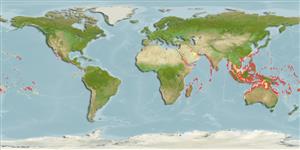>
Gobiiformes (Gobies) >
Microdesmidae (Wormfishes) > Ptereleotrinae
Etymology: Ptereleotris: Greek, pteron = wing, fin + The name of a Nile fish, eleotris (Ref. 45335).
More on author: Bleeker.
Environment: milieu / climate zone / depth range / distribution range
Ecología
marino asociado a arrecife; rango de profundidad 1 - 50 m (Ref. 27115), usually 1 - 10 m (Ref. 48637). Tropical; 22°C - 27°C (Ref. 27115); 30°N - 30°S
Indo-Pacific: Red Sea to the Line and Tuamoto islands, north to the Ryukyu Islands, south to the southern Great Barrier Reef.
Tamaño / Peso / Age
Maturity: Lm ? range ? - ? cm
Max length : 13.0 cm TL macho / no sexado; (Ref. 9710)
Espinas dorsales (total) : 7; Radios blandos dorsales (total) : 25 - 29; Espinas anales: 1; Radios blandos anales: 24 - 27; Vértebra: 26 - 27. Pale to bluish gray in color; pectoral fin base with a narrow, pale blue-edged, black band; postorbital head with irregular, pale to iridescent blue bands and spots. Chin with a median, fleshy protuberance narrowing to a thin fold. Scales embedded, close-set, non imbricate (except on posterior part). 1st dorsal fin lower than 2nd; 2nd dorsal and anal fins elevated anteriorly. Closely resembles P. heteropterus but lacks the blue mark on the tail (Ref. 1602).
Inhabits lagoon and seaward reefs, over rubble and sand bottoms (Ref. 9710). Found from shallow silty estuaries and inlets to outer reef lagoons to about 10 meters depth, but may also be seen deep on coastal slopes to 25 meters depth (Ref. 48637). Occur in pairs occupying the same burrow, but at times more than 2 individuals will retreat to the same refuge (particularly true for juveniles). Monogamous (Ref. 52884). Feeds on zooplanktons (Ref. 89972).
Life cycle and mating behavior
Madurez | Reproducción | Puesta | Huevos | Fecundidad | Larva
Monogamous mating is observed as both obligate and social (Ref. 52884).
Randall, J.E. and D.F. Hoese, 1985. Revision of the Indo-Pacific dartfishes, genus Ptereleotris (Perciformes: Gobioidei). Indo-Pac. Fish. (7):36 p. (Ref. 528)
IUCN Red List Status (Ref. 130435: Version 2024-1)
Threat to humans
Harmless
Human uses
Pesquerías: comercial; Acuario: Comercial
Herramientas
Special reports
Download XML
Fuentes de Internet
Estimates based on models
Preferred temperature (Ref.
123201): 25 - 29.3, mean 28.4 °C (based on 3870 cells).
Phylogenetic diversity index (Ref.
82804): PD
50 = 0.5000 [Uniqueness, from 0.5 = low to 2.0 = high].
Bayesian length-weight: a=0.00389 (0.00180 - 0.00842), b=3.12 (2.94 - 3.30), in cm total length, based on all LWR estimates for this body shape (Ref.
93245).
Nivel trófico (Ref.
69278): 3.4 ±0.4 se; based on size and trophs of closest relatives
Fishing Vulnerability (Ref.
59153): Low vulnerability (10 of 100).
Nutrients (Ref.
124155): Calcium = 107 [57, 179] mg/100g; Iron = 0.809 [0.489, 1.346] mg/100g; Protein = 18.1 [17.0, 19.1] %; Omega3 = 0.0981 [, ] g/100g; Selenium = 30.9 [14.7, 64.3] μg/100g; VitaminA = 195 [67, 591] μg/100g; Zinc = 1.82 [1.22, 2.55] mg/100g (wet weight);
